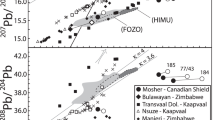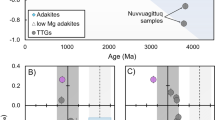Abstract.
Major and trace element and Sr–Nd–Pb–O–C isotopic compositions are presented for carbonatites from the Cape Verde (Brava, Fogo, Sáo Tiago, Maio and Sáo Vicente) and Canary (Fuerteventura) Islands. Carbonatites show pronounced enrichment in Ba, Th, REE, Sr and Pb in comparison to most silicate volcanic rocks and relative depletion in Ti, Zr, Hf, K and Rb. Calcio (calcitic)-carbonatites have primary (mantle-like) stable isotopic compositions and radiogenic isotopic compositions similar to HIMU-type ocean island basalts. Cape Verde carbonatites, however, have more radiogenic Pb isotope ratios (e.g. 206Pb/204Pb=19.3–20.4) than reported for silicate volcanic rocks from these islands (18.7–19.9; Gerlach et al. 1988; Kokfelt 1998). We interpret calcio-carbonatites to be derived from the melting of recycled carbonated oceanic crust (eclogite) with a recycling age of ~1.6 Ga. Because of the degree of recrystallization, replacement of calcite by secondary dolomite and elevated ∂13C and ∂18O, the major and trace element compositions of the magnesio (dolomitic)-carbonatites are likely to reflect secondary processes. Compared with Cape Verde calcio-carbonatites, the less radiogenic Nd and Pb isotopic ratios and the negative Δ7/4 of the magnesio-carbonatites (also observed in silicate volcanic rocks from the Canary and Cape Verde Islands) cannot be explained through secondary processes or through the assimilation of Cape Verde crust. These isotopic characteristics require the involvement of a mantle component that has thus far only been found in the Smoky Butte lamproites from Montana, which are believed to be derived from subcontinental lithospheric sources. Continental carbonatites show much greater variation in radiogenic isotopic composition than oceanic carbonatites, requiring a HIMU-like component similar to that observed in the oceanic carbonatites and enriched components. We interpret the enriched components to be Phanerozoic through Proterozoic marine carbonate (e.g. limestone) recycled through shallow, subcontinental–lithospheric–mantle and deep, lower-mantle sources.
Similar content being viewed by others
Author information
Authors and Affiliations
Additional information
Electronic Publication
Rights and permissions
About this article
Cite this article
Hoernle, K., Tilton, G., Le Bas, M.J. et al. Geochemistry of oceanic carbonatites compared with continental carbonatites: mantle recycling of oceanic crustal carbonate. Contrib Mineral Petrol 142, 520–542 (2002). https://doi.org/10.1007/s004100100308
Received:
Accepted:
Issue Date:
DOI: https://doi.org/10.1007/s004100100308




